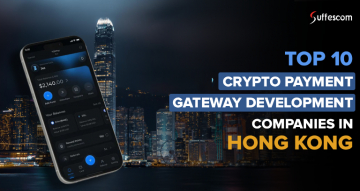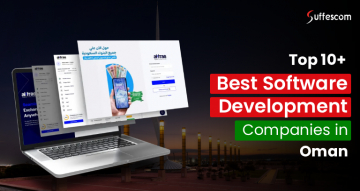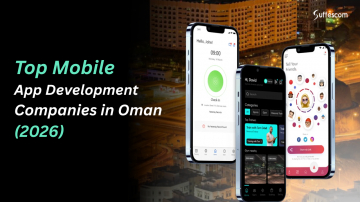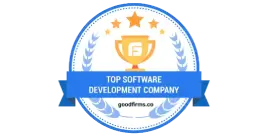How To Develop A Property Management App in 2025?
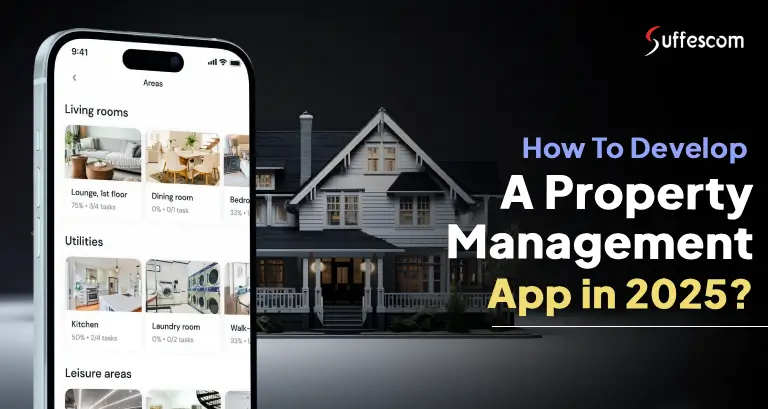
Over the past few years, the approach to managing properties has undergone a transformation with the increasing demand for intelligent and digital-first solutions. Moreover, property management has gone beyond paperwork and in-person meetings. With the rise of PropTech 2025, handling real estate business has become faster and more reliable for landlords, agencies, and all tenants. This shift happened due to the use of property management apps. These apps perform tasks that used to take days or weeks and help everyone stay connected in real time.
A recent report stated that the global property management market was valued at $24.18 billion in 2024. It is further anticipated to grow from $26.55 billion to $52.21 billion by 2032, which is a significant rise. This growth has also increased the requirement for real estate software development. For property owners, a property management application will help them receive rent, manage maintenance requests and inquiries, and track expenditures all in one place. Tenants benefit because they can pay their rent online and can have the information about the lease at any point in time.
So, if you are looking to develop a property management app? This blog will provide you with detailed information on its key features, benefits, challenges, and more.
Why Property Management Apps Are Thriving in 2025
In 2025, the real estate industry embarked on another level of digital transformation, and one of the most emerging aspects is PropTech. The high momentum is due to a combination of urban expansion and the inefficiencies of outdated systems still in use across many markets.
Landlords and agencies are not only opting for digital property management to enhance their services but also to stay competitive since transparency is important in the real estate sector. The transition from offline to online is an expected requirement for both tenants and stakeholders.
Shift from Manual to Automated Systems
Conventional property management was based on the usage of spreadsheets, paperwork, and slow communication. Conversely, new technology in property management applications provides fully automated platforms that eliminate fragmented processes.
Furthermore, recurring tasks, such as rent notices, lease renewals, maintenance bookings, and payment confirmations, are now handled by the system. This eliminates human error and makes the response time faster.
Benefits for Property Managers and Owners
The value of these apps is immediate and measurable. A single platform provides access to:
- Centralised Property Management: Monitor multiple properties simultaneously on a single screen with live situation reports and controls.
- Automated Rent Collection: Automate subscriptions on a monthly basis, automatic reminders, receipts, and money tracking.
- Maintenance Management: It accepts and assigns the maintenance requests and tracks them without phone calls and paperwork.
- Document Storage: Keep and retrieve lease files, tenant backgrounds, and ID records in one digital place.
- Direct Tenants Communication: Communication with tenants in real-time via in-app messaging and notification text.
- Performance Analytics: Access to the level of occupancy, payment trends, and spending patterns to formulate sound decisions.
- Task Automation: Automate things that are going to happen regularly, like renewing leases, creating late fees, and scheduling services.
Key Features of a Successful Property Management App
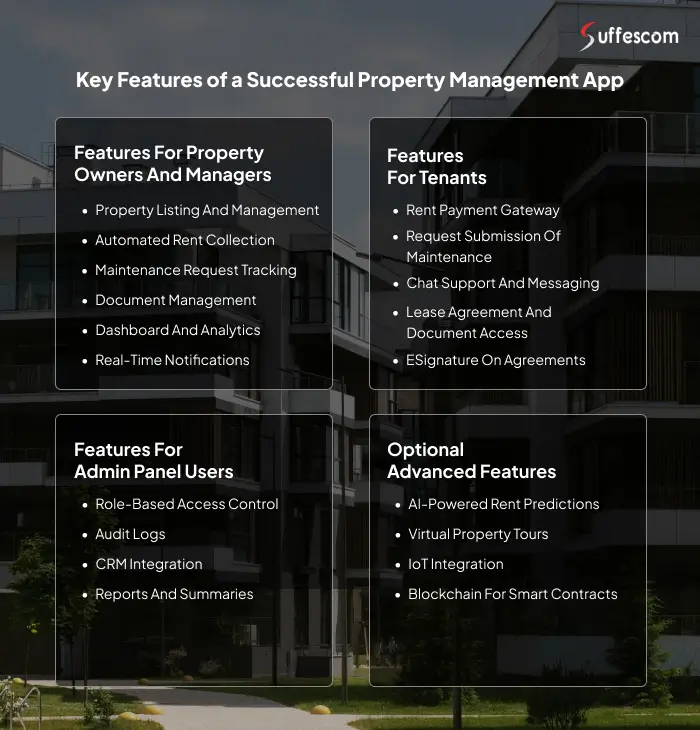
In 2025, a property management app is expected to do more than just basic record-keeping. So, let’s delve into the most important features that would provide the best outcome if you are planning to build a property management software:
Features for Property Owners and Managers
- Property Listing and Management: This feature lets owners add, update, and organise all property details in one place. It helps keep track of units, leases, and tenant status with complete visibility.
- Automated Rent Collection: This feature gives landlords an opportunity to have auto reminders of monthly rents and the option for tenants to make payments online, which further helps in decreasing delays and makes the cash flow pattern uniform.
- Maintenance Request Tracking: Using this feature, the owners will be able to get repair requests, assign them to the contractor, and follow their progress through the stages till the end of the app.
- Document Management: It will assist in keeping contracts of rent, identification evidence, and all such documents in one place, where they can always be extracted at any given time.
- Dashboard and Analytics: The feature provides owners with key performance indicators of the property in terms of rent income, overdue payments, and occupancy trends of the properties to facilitate faster business decisions.
- Real-Time Notifications: The owners are immediately alerted about received rent, a lease expiring, or a new repair request in the app. This assists them in working without delays.
Features for Tenants
- Rent Payment Gateway: This feature allows tenants to pay rent online via cards or wallets. The transactions are instant, safe, and real-time, reflected in the system of the app.
- Request Submission of Maintenance: The tenants are able to complain of broken appliances, plumbing faults, and add photographs to them, and are able to follow up on repairs without having to contact the landlord.
- Chat Support and Messaging: This feature will assist the tenants to talk directly to the property managers or support teams within the app, which makes communication easier and more organised.
- Lease Agreement and Document Access: The notices, lease, and receipt of rent can be seen by the tenants at any time.
- eSignature on Agreements: An eSignature feature enables the tenants to sign the rental contracts or renewing deals electronically, eliminating paperwork and wasting time on both sides.
Features for Admin Panel Users
- Role-Based Access Control: Admins have the possibility to provide various members of the team with access to certain features of the app. As an example, accountants have access to finances, whereas leasing agents are in charge of listings.
- Audit Logs: This aspect follows all steps that have been taken in the application, recording who has done what and when. It makes it transparent and less likely to cause errors or misuse.
- CRM Integration: This functionality links the app to already used customer management or accounting tools, enabling teams to work with information without the need to make additional efforts and transfer to a new platform.
- Reports and Summaries: The admins can make reports regarding the rent collection, open maintenance tickets, or tenant activity. Such summaries facilitate the proper management of property portfolios.
Optional Advanced Features
- AI-Powered Rent Predictions: This feature utilises Artificial Intelligence to anticipate market trends and location data, providing accurate rent prices. It assists in pricing at the level of demand and competition.
- Virtual Property Tours: The rental units are advertised online, so a feature where tenants can take 3D tours or videos would be beneficial.
- IoT Integration: The app can be linked to such smart lock and thermostat devices. This feature promotes security and the ability of the tenants to use the appliances remotely.
- Blockchain for Smart Contracts: The lease agreements can be stored using blockchain to make the agreements tamper-proof, secure, and legally acknowledged. This introduces honesty and transparency in leasing.
Types of Property Management Software
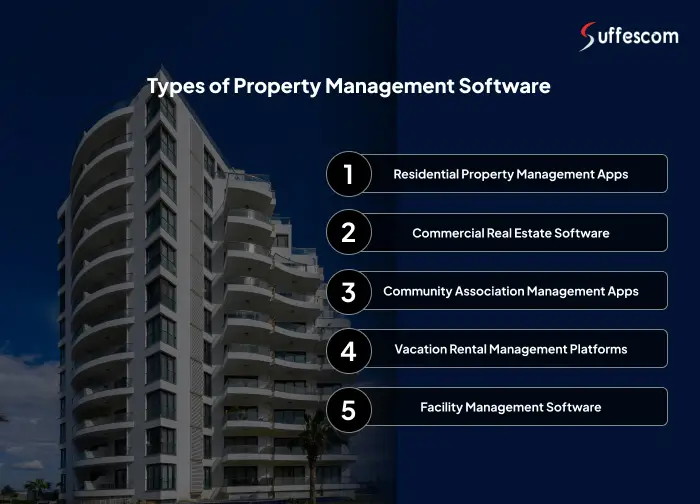
Not all property management apps are developed in the same way. Depending on the type of property you manage and the audience you serve, different property software management platforms are developed. The following are the most common types of property management software used today.
Residential Property Management Apps
These apps are designed for landlords and property managers who deal with apartments, villas, duplexes, or single-family houses. The software normally has the rental collection, tracking leases, maintenance requests, and communicating with the tenants tools. It enables landlords to control all processes of a tenant, such as contract hiring to renewals of leases, at the same time. These apps are most applicable when it comes to long-term renting and small to medium-sized property portfolios.
Commercial Real Estate Software
Commercial property software focuses on the needs of those managing office buildings, retail spaces, industrial warehouses, or mixed-use developments. These platforms provide lease customisation modules, unit-based billing, utility tracking, and contract management for numerous tenants in the same property. They also manage more term leases and complicated billing cycles that are so prevalent in commercial leasing.
Community Association Management Apps
This software is designed to run residential estates like gated societies, multi-unit complexes, or even housing associations. It facilitates communications among the members, community, facility reservations, security records, and the maintenance of the common areas. It also keeps the board members and community managers organised with all the documents of meetings, payments, and notices stored in a single electronic place.
Vacation Rental Management Platforms
They are most suitable for property owners or agents renting out houses, apartments, and the like on short-term leases, just like Airbnb. Functionalities typically provided in the software are booking calendars, a payment gateway, guest communication, and interconnections with travel platforms. It eases the process of automation in check-ins and reviews on visitors to handle high turnover and seasonal pressure.
Facility Management Software
Facility management software deals with the day-to-day operations of buildings and infrastructure. Organisations use it to monitor all things, including HVAC systems, electrical maintenance, safety inspections, and energy expenditure. Such software is more applicable in bigger commercial premises, hospitals, universities, or government buildings because it is in these places that equipment maintenance and inspection are continuous and strictly controlled.
These types of rental software are designed to address various issues. The selection depends on the type of property you have, the number of units you need to list, the frequency of tenant turnover, and the type of experience you wish to provide. Whether you manage a vacation house or a multi-story office building, it is always easier to manage it with a specialised tool and provide more qualified service.
Ready to Bring Your Property App Idea to Life?
Contact our app development company today and turn your concept into a powerful management solution.
Step-by-Step Property Management App Development Process
To develop a property management app in 2025 involves planning, research, development, and ongoing improvement. Let’s delve into the key steps required for the best property management app.
1. Market Research and Competitor Analysis
Before building the app, it’s important to understand what’s already out there. Analyse the best apps to understand what things they present and how they assist their users. This study will also enable you to identify areas where these applications are lacking, features that users often complain about, and where these applications cannot perform effectively. Real reviews will help you create something more specific and better.
2. Define App Requirements and Features
After conducting your research, outline what your app will require. Begin with the basics like rent collecting, maintenance requesting, communication with the tenants, and administration of leases. Then decide on additional features, such as AI rent predictions or virtual tours. Generating user personas also makes the app focused on addressing real problems.
3. Choose the Right Platform: iOS, Android, or Cross-Platform
After defining requirements, you need to choose the appropriate platform. When your target audience includes both Android and iPhone users, it can be useful to make cross-platform apps using frameworks like Flutter or React-Native. In contrast, if you are aiming for a particular group of users with different tastes and preferences, native development might provide better performance and control over features.
4. Create Wireframes and UI/UX Design
After client approval, it is time to design your property management app. A wireframe serves as a blueprint of how every screen is designed. With apps such as Figma or Adobe XD, the designers can create prototypes in an interactive form. A good design implies that a user will not be lost trying to carry out a task.
5. Backend and Frontend Development
In this step, app developers begin building the application's frontend and backend once the design is complete. The backend handles all processing, databases, and server-side operations, where your app receives payment, stores information, and alerts. In most cases, technologies such as Node.js, Django, or Laravel are commonly used. The part that users see and use is the frontend. Apps can be created using mobile frameworks like Flutter or React Native to look good and function well.
6. Testing and Quality Assurance
When the development is done, the app is tested. Testers verify whether the app is functioning normally on other devices and in different scenarios. The manual testing involves usability and layout, and automated testing involves bugs, crashes, or security defects. Security testing is particularly applicable in property management apps, given that such apps deal with sensitive information such as payment data and identification documents containing personal information.
7. Deployment and Launch
When the testing phase is completed, the app is submitted to the App Store and Google Play Store. For app submission, you will write an effective app description, add screenshots, and ensure it is compatible with all the store's requirements. Once the property management app is deployed, get a user response and monitor anomalies in performance.
You can also partner with a real estate app development company to get further insights and change your vision into a beautiful app.
UI/UX Best Practices in 2025 for PropTech Apps
User experience and interface design have become critical success factors for property management apps, as 88% of users are less likely to return after a bad user experience. In 2025, users want a clean interface, fast navigation, and widely available features on all types of devices. Here are some of the most essential mobile app design 2025 practices for your property management app:
1. Minimal Design, Maximum Functionality
Property management apps today primarily focus on displaying basic information. Once users log in, important actions or activities, such as rent payment, new notifications, or building maintenance, should be visible without requiring scrolling or browsing through menus.
- Simple home screens enhance concentration, as the most frequently used features are brought to the forefront.
- To lessen screen clutter, less colour and white space can be utilised to help focus more.
- Organising non-priority features in folding menus will keep the interface tidy and, at the same time, provide more detail if necessary.
2. Accessibility & Localisation
Property management apps should operate for everyone, regardless of physical ability, location, or anything. Designing the app with users in mind can help you achieve the best outcome.
- Voice input and screen reader support make using the service convenient, even for those with visual impairments.
- The ability to resize text and choose high-contrast colours helps visually impaired people see what they are reading.
- Support for multiple languages, including right-to-left (RTL) languages for Arabic layout, provides the convenience of using the app to regional audiences.
3. Micro Animations & Interactions
The little, immediate responses that the user receives during the usage of the app are equally significant as the features. Such interactions increase confidence and help users to know what is going on behind the scenes.
- Little haptic feedback in the form of animated checkmarks or loading bars indicates that payment of rent or form submission happens successfully.
- There should be real-time highlights, which will remind users in the tenant management apps when they provide inaccurate information.
- Loading in progress status bars can keep the user more patient, even when it takes a little bit longer to do an action, such as uploading a document or syncing data.
4. Dark Mode and Custom Themes
Customisation plays a growing role in user comfort and branding. Users want control over how their apps look, especially in low-light settings.
- Dark mode helps reduce some pressure on the eyes and is a popular choice, especially when used at night or for extended periods of screen time.
- Property managers should be able to choose the colours and the logos of the property management system to help in strengthening brand identity and trust among tenants.
- In light and dark themes, colour contrast guidelines have to be adhered to so as to be easily viewed by everyone.
5. Mobile-First, Not Mobile-Only
Mobile phones are used by tenants, and the landlords and admins prefer to use tablets or desktops. A robust UX for real estate apps should also have the ability to provide the same consistency when it comes to screens and responsiveness.
- The ease of use of common actions on the small screens is one of the reasons mobile-first designs are increasing.
- The tablet and desktop designs need to have extra options such as downloading a report, bulk actions, or many property views.
- A uniform navigation structure will allow a user to switch between devices and experience it in the same manner, making it easy.
Top Technologies Used in Property Management App Development
Developing a powerful property management app in 2025 will require the successful selection of a combination of technologies. Below is an overview of the most important technologies that are usually employed to develop modern PropTech solutions.
Mobile Technologies
The selection of a mobile framework has a direct influence on the property management app. Let’s discuss the key technologies used in it.
- Flutter and React Native are used to build apps for both Android and iOS using a single codebase.
- Swift is employed in native iOS development, where a high level of performance and integration with Apple devices is demanded.
- Kotlin is preferred for native Android apps, offering improved security features and compatibility with older Java-based systems.
Backend Frameworks
The back end of a property management application relies on a backend. It handles data processing and authentication with external APIs. Let’s discuss key technologies used in the backend of the app:
- Django is employed because of its security features, and it is most applicable in creating elaborate applications that involve user privileges and document transactions.
- Laravel also has clean architecture, and thus it is widely used to create a secure and scalable web backend.
- Node.js is very common because it is very high-performing and accommodates a large amount of data.
Database
Selecting the correct database will ensure that the app can deal with vast amounts of information. Let’s discuss the key technologies used for the database.
- PostgreSQL is strong, and it is helpful for structured data, becoming preferable in reporting and analytics.
- MongoDB is a versatile, document-oriented database that is popular when there is a need to have fast iterations of apps or unstructured data.
- Firebase is a combination of real-time synchronization and cloud storage, making it applicable to push notifications and mobile applications.
APIs / Integrations
The property apps are dependent on third-party services to increase their functions. These integrations prevent time waste, and extra features are introduced without remaking everything on their own. Let’s discuss the key APIs:
- Twilio allows SMS, voice calls, and two-factor verification inside the app, enhancing contact with tenants and work providers.
- Stripe facilitates safe Internet transactions, thus making rent, deposits, or service cost collection less cumbersome.
- Google Maps integration gives an opportunity to see the location of the property, verify distances, and activate the pre-formed functions, such as the ability to use GPS to see directions or check-ins.
- AWS S3 can be employed in cases of large file storage, like high-resolution images and PDFs.
Security Technologies
PropTech apps are very sensitive in terms of security since they handle important tenant information, money transactions, and sensitive documents. Let’s discuss some of the technologies used for the security of the property management app.
- SSL encryption also provides security for all data being exchanged between the app and the servers.
- OAuth 2.0 is a safe login system that helps the user log in by means of some trusted external services, such as Google or Microsoft.
- The end-to-end encryption secures the chat messages and document sharing among tenants, landlords, and administrators.
AI & ML for Property Insights
Artificial Intelligence is becoming a major part of PropTech innovation. Let’s discuss how AI & ML help in changing the property management sector.
- AI-driven rent estimators use local market data to suggest the best rental price for a unit.
- Machine learning algorithms help identify maintenance issues early by analyzing patterns and feedback.
- AI chatbots can answer tenant questions, guide them through payments, or assist with form submissions 24/7, reducing the need for live support.
How Much Does It Cost to Build a Property Management App in 2025?
The cost to build a property management app in 2025 is based on the features, team organisation, and solution scope. Knowing the exact property management software development cost will help you decide on everything. Let’s explore the cost by key development stages:
- Discovery & Research: It takes approximately $1,000 to $3,000 on discovery and research that covers business analysis, user research, competitive analysis, benchmarking, and feature set.
- UI/UX Design: This phase costs around $2000-$5000, depending on the requirement. For instance, if you want the app to be compatible with all types of devices, it would cost more.
- Development: The development cost is between $4,000 and $8,000, depending on the feature set integration, frontend, backend, and third-party integrations like maps and payment gateways.
- QA and Launch: The costs of testing and quality assurance ideally fall between $1,000 and $4,000 and will involve functional testing, compatibility testing with other devices, and security-based audits alongside performance testing.
- Maintenance & Post-Launch Support: Post-launch maintenance begins at $1,000 per month, covering updates, bug fixes, cloud server costs, and new features introduced to the user base.
Cost Comparison Table
| App Development Phase | Estimated Cost |
| Discovery & Research | $1,000 – $3,000 |
| UI/UX Design | $2,000 – $5,000 |
| Development | $4,000 – $8,000 |
| QA and Launch | $1,000 – $4,000 |
| Maintenance & Support | $1,000/month |
Cost by Team Type
The budget is highly determined by who you employ in terms of development. There are different team models that impact the overall app development cost.
In-house Team: This is the most costly model, which is an in-house team, where you have full control over the communication, progress, and direction. It is optimized for enterprise-scale applications or the development of long-running applications.
Outsourcing: The next model is partnering with a software development company. All the app developers, designers, and QA engineers are already in a team, but the price is not split into separate positions. The agency you choose will determine the final cost, which is influenced by its location, experience, and the complexity of your application.
Freelancers: This model offers the most affordable solution but comes with risks in coordination and accountability. They're suitable for short-term or prototype-level work.
Different Hiring Models
| Model | Cost & Control | Best For |
| In-house Team | High cost, full control over the team and the project | Enterprise-scale or long-term applications |
| Outsourcing | Medium cost, moderate control via project managers | Full app development with a reliable external team |
| Freelancers | Low cost, limited control, and coordination challenges | Short-term, small-scale, or prototype development |
Cost by App Type
Another factor that influences app development cost is the complexity of the property management app. Here are the three app types that can impact the budget.
Basic App: The cost of a basic application is approximately $8000 to $10,000, and it typically includes features such as login, rent tracking, maintenance requests, notifications, and a simple dashboard.
Mid-level App: It will cost between $10,000 and $15,000 with features such as CRM integration, automation of lease documents, analytics, and multi-role dashboards for administration, tenants, and owners.
Advanced App: The more advanced the app's functionality, the more expensive it becomes. An advanced model can cost $ 15,000 to $ 20,000+, as it will include AI-powered custom feature integrations.
Cost Comparison based on App Complexity
| App Complexity | Cost Range |
| Basic App | $8000-$10,000 |
| Mid-Level App | $10,000-$15,000 |
| Advanced App | $15,000-$20,000 |
Monetization Strategies for Property Management Platforms

After developing your property management app, you will need to apply effective monetization strategies that will generate income and boost ROI. So, let’s discuss some of the major monetization strategies that you use in the property management app in 2025:
Subscription Model: In this type of model, the users will be charged monthly or annually, in order to keep using the platform. It is effective for landlords, agencies, and property managers who prefer to have predictable costs. It is possible to make various pricing levels according to the number of properties, features, or user roles.
In-app purchases: The freemium models allow basic features to be used freely, while the advanced tools are paid additions. As an example, its rent collection and maintenance log may be free, but signing a lease digitally or more analytics will be behind a paywall. This model is perfect to increase the number of users.
Transaction Fees: In case your app takes payments, you may charge a small transaction fee on any rent or service payment. This payment may be a rate, and sometimes a percentage, or may be paid by the landlord or tenant. It is particularly good in applications with high financial or billing capabilities.
Ad-based Revenue: In this monetization model, you can generate revenue by showing ads in your property management app. Applications with high user engagement may earn a lot of revenue. Ads that relate to property, such as the moving service, insurance, or home repairs, may be included in an unobtrusive manner.
White-Label Licensing: When your app is versatile and well developed, you will have the chance to sell it to other companies as a white-labeled product. You can keep the backend, and clients can rebrand it to their logo and colours. The license may involve one-time setup, customization, and recurring subscription prices, which intensify it to be a robust business growth.
Compliance, Security, and Data Privacy in Property Management Apps
In 2025, property management apps should safeguard sensitive information like tenant ID, leases, and payment information. Real estate compliance 2025 and security not just create legal protection but also develop trust amongst the users. Here are some areas of focus:
Regulatory Compliance
Property management apps have to comply with regional privacy regulations, such as GDPR and CCPA, in order to be lawful in the usage of user information. Key requirements include:
- GDPR requires consent of users, the right to data portability, and deletion.
- CCPA focuses on consumer rights in California and provides opt-out possibilities.
- Guarantee that privacy policies are easy, up to date, and accessible for free.
Secure Payment Gateways
Secure financial transactions are critical to avoid data breaches and legal issues. Key requirements include:
- Use PCI-DSS compliant gateways like Razorpay.
- Never store raw credit card details; use tokenization instead.
- Send instant receipts for every payment processed.
Authentication and Access Control
Only verified users should access sensitive data. Strong login systems help prevent misuse. Key requirements include:
- Incorporate two-factor authentication (2FA).
- Assign role-based access based on user type.
- Enforce strong password rules with secure reset options.
Data Encryption and Privacy Protection
Encryption helps to store and transmit the data of the users securely. Key requirements include:
- Make sure that communication is secure through the use of SSL/TLS.
- Encrypt data stored with AES-256 or preferably.
- Avoid the unnecessary personal data collection.
Audit Trails and Activity Monitoring
Monitoring user activity helps detect threats and ensures accountability. Key requirements include:
- Log key actions like logins, payments, and data edits.
- Alert admins to suspicious activity.
- Review logs regularly for compliance and risk prevention.
Common Challenges in Property Management Apps and How to Overcome Them
Building a property management app comes with technical and operational hurdles. Let’s discover some of them:
Data Migration from Legacy Systems
Outdated or manual systems have already been used by many property owners and real estate companies. By shifting their data to a new app, they can create the possibility of losing their data, making such a process complicated unless done correctly.
- Before importing the data, perform normalization and data cleaning.
- Import tools that allow preview and rollback to be used to prevent migrating mistakes that are irrecoverable.
- Provide individual onboarding or migration assistance to help clients transition smoothly and maintain trust.
Multi-device Syncing
Your users might switch between their mobile, tablet, and desktop over the course of a day. When data fails to sync, it creates confusion.
- Create real-time syncing features using Firebase or WebSockets to keep all devices updated in parallel.
- Perform test sync functionality on various devices with different screen sizes and different internet speeds.
- Store caches data locally when offline, and automatically synchronizes them when the device gets connected to the internet.
Offline Capabilities
Not all users are always connected to the internet, and this mostly applies to tenants or maintenance staff. Offline functionality makes it possible to maintain the usability of the app in these circumstances.
- It should have the ability to allow users to file a maintenance request, get receipts, or even see the lease documents when offline and save the information locally.
- Queue offline actions and sync them automatically when the internet connection is restored by designing the app to do so.
- Make the offline and the syncing progress clearly visible to the user to make them aware of when the next update will be implemented.
Real-Time Updates
In the management of property, it is important to have timely information. Delays can be a real problem, whether it is a reminder that a rent is due or you need a repair that is urgent.
- Use push notifications to notify users about important actions.
- Dashboards where property managers can view new requests or updates on leases.
- Guarantee that the notification settings are customizable, providing users with the option to decide on which alerts they want to receive.
Language & Regional Customization
Real estate is a local business, and property apps serve users in different regions and cultures.
- Provide multi-language capabilities, with RTL (right-to-left) direction facility.
- Not only should the language be localized, but also the formats of currency, how data works, and the units of measurement, depending on the region of the user.
- Offer customer support services in many languages to enhance satisfaction and retention of the users.
Future Trends in Property Management Software Development 2025
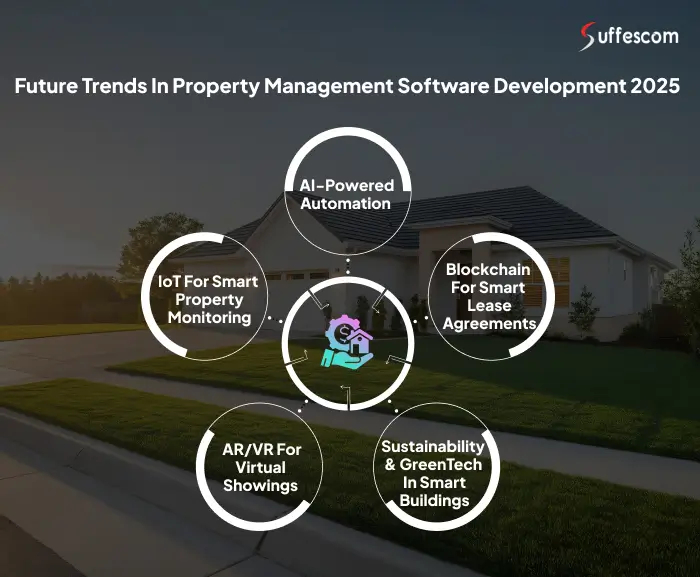
As this PropTech sector is rising quickly, it is clear that it has a lot of potential in the future as well. So, let’s discover some of the future real estate tech trends in real estate software development:
1. AI-Powered Automation
AI in real estate apps is significantly helping in automating tasks and decision-making.
- AI-powered chatbots are used to provide answers to tenant questions, set up viewings, and provide initial assistance around the clock.
- Predictive analytics can make forecasts of rent prices based on surrounding market trends, living capacity, and seasonal temperature patterns.
2. Blockchain for Smart Lease Agreements
Blockchain technology is bringing transparency and security to transactions through the utilisation of smart contracts and digital document management.
- Smart leases can be signed, verified, and incorporated automatically without human intervention.
- Blockchain-based systems can store payment histories, identity verification, and agreement renewals securely.
3. IoT for Smart Property Monitoring
The Internet of Things (IoT) is changing physical buildings into connected environments.
- Smart locks enable tenants or staff to access buildings with digital keys.
- Motion sensors help keep an eye on properties, and instant alerts are sent to prevent losses.
4. AR/VR for Virtual Showings
Augmented reality and virtual reality are transforming the rental experience of tenants who do not need to go anywhere since everything is virtually available.
- Potential clients will have the opportunity to look at the properties via the VR goggles or phones, regardless of their location across the globe.
- The staging tools would allow imagining where the furniture might be placed and how layouts should be changed to increase the conversion rate of those who rent the place.
5. Sustainability & GreenTech in Smart Buildings
With the current rise in awareness of climate change, commercial tenants, landlords, and property owners demand sustainable advantages embedded into the actual property as well as the software of the application.
- Real-time electricity, water, and gas usage can be displayed on energy efficiency dashboards in order to increase conservation.
- Smart scheduling systems can automate everything based on occupancy patterns.
Conclusion
The real estate industry is changing quickly, and a property management app has become a requirement in 2025. For every task, from managing rental units to an extensive real estate portfolio, a digital platform helps you enhance tenant experiences. Moreover, developing a property management app is not just about going digital. It is more about building such an experience that brings long-term value through automation and smart analytics.
If you're ready to create a smarter property management solution, now is the right time to start. Partner with Suffescom, a mobile app development company that understands the real estate domain and can help turn your vision into an app.
Book a Free Consultation with Our App Development Team
Discuss your project needs and explore our property management development services, which are designed to fit your business model.
FAQs
1. What is a property management app, and how does it operate?
A property management app is a solution that automates tasks like rent collection, communication with the tenant, and lease management for property owners, tenants, and agencies. These apps operate by centralising all the data in a single interface, which is accessible through mobile and web platforms.
2. What features should I prioritize in the MVP version of a property management app?
The features you should prioritize in the MVP version of a property management app are:
- Property Listing
- Tenant Onboarding
- Rent Payment System
- Maintenance Request Tracking
- Chat Support
- Document Access
3. How long does it usually take to build a property management app in 2025?
The time required to build a property management app in 2025 will typically range from 4 to 8 months, depending on your requirements and the integration of features.
4. How much does it cost to develop a property management app?
The cost to develop a property management app starts from $8,000 to $20,0000. Factors on which the cost depends are:
- App complexity
- Platform type
- Design requirements
- Post-launch support
5. Can I integrate a property management app with existing ERP or CRM systems?
Yes, you can integrate a property management app with existing ERP or CRM systems through APIs or third-party connectors.
6. How secure are property management apps for handling tenant data?
Property management applications in 2025 are built with advanced security features like:
- SSL encryption
- 2FA (two-factor authentication)
- GDPR/CCPA compliance
- Secure payment gateways
7. How can custom property management software benefit my business in 2025?
Custom property management software can benefit your business in 2025 by:
- Simplifying operations
- Reducing Manual Errors
- Instant Communication
- Making informed decisions
- Quick turnaround times
8. Do I need a different app for tenants and property managers?
No, you don’t need separate apps for tenants and property managers, but a multi-role architecture model is needed to allow different user interfaces and dashboards.
9. What are the monetisation strategies I can include in my property management app?
The monetisation strategies that you can incorporate in your property management app are:
- Subscription Model
- Freemium + In-app Purchases
- Transaction Fees
- Ad-based Revenue
10. Which programming languages are best for PropTech app development in 2025?
The best programming languages for PropTech app development in 2025 include:
- React Native or Flutter for the frontend
- Node.js, Python, or Ruby on Rails for the backend
11. What are some examples of top-performing property management apps in the market?
Some examples of top-performing property management apps in 2025 include
- Buildium
- AppFolio
- TenantCloud
- Rentec Direct
- Propertyware

